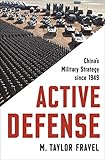Active Defense : China's Military Strategy since 1949 / M. Taylor Fravel.
Material type: TextSeries: Princeton Studies in International History and Politics ; 167Publisher: Princeton, NJ : Princeton University Press, [2019]Copyright date: ©2019Description: 1 online resource (396 p.) : 1 b/w illus. 6 maps. 2 tablesContent type:
TextSeries: Princeton Studies in International History and Politics ; 167Publisher: Princeton, NJ : Princeton University Press, [2019]Copyright date: ©2019Description: 1 online resource (396 p.) : 1 b/w illus. 6 maps. 2 tablesContent type: - 9780691152134
- 9780691185590
- 355/.033551 23
- UA835 .F73 2019.
- UA835 .F73 2019
- online - DeGruyter
- Issued also in print.
| Item type | Current library | Call number | URL | Status | Notes | Barcode | |
|---|---|---|---|---|---|---|---|
 eBook
eBook
|
Biblioteca "Angelicum" Pont. Univ. S.Tommaso d'Aquino Nuvola online | online - DeGruyter (Browse shelf(Opens below)) | Online access | Not for loan (Accesso limitato) | Accesso per gli utenti autorizzati / Access for authorized users | (dgr)9780691185590 |
Browsing Biblioteca "Angelicum" Pont. Univ. S.Tommaso d'Aquino shelves, Shelving location: Nuvola online Close shelf browser (Hides shelf browser)

|

|

|

|

|

|

|
||
| online - DeGruyter Fugitive Democracy : And Other Essays / | online - DeGruyter A World Divided : The Global Struggle for Human Rights in the Age of Nation-States / | online - DeGruyter Global Development : A Cold War History / | online - DeGruyter Active Defense : China's Military Strategy since 1949 / | online - DeGruyter Strategic Instincts : The Adaptive Advantages of Cognitive Biases in International Politics / | online - DeGruyter American Bonds : How Credit Markets Shaped a Nation / | online - DeGruyter How the Classics Made Shakespeare / |
Frontmatter -- CONTENTS -- ILLUSTRATIONS -- ACKNOWLEDGMENTS -- ABBREVIATIONS -- Introduction -- 1. Explaining Major Change in Military Strategy -- 2. The CCP's Military Strategies before 1949 -- 3. The 1956 Strategy: "Defending the Motherland" -- 4. The 1964 Strategy: "Luring the Enemy in Deep" -- 5. The 1980 Strategy: "Active Defense" -- 6. The 1993 Strategy: "Local Wars under High- Technology Conditions" -- 7. China's Military Strategies since 1993: "Informatization" -- 8. China's Nuclear Strategy since 1964 -- Conclusion -- BIBLIOGRAPHY -- INDEX -- A NOTE ON THE TYPE
restricted access online access with authorization star
http://purl.org/coar/access_right/c_16ec
What changes in China's modern military policy reveal about military organizations and strategySince the 1949 Communist Revolution, China has devised nine different military strategies, which the People's Liberation Army (PLA) calls "strategic guidelines." What accounts for these numerous changes? Active Defense offers the first systematic look at China's military strategy from the mid-twentieth century to today. Exploring the range and intensity of threats that China has faced, M. Taylor Fravel illuminates the nation's past and present military goals and how China sought to achieve them, and offers a rich set of cases for deepening the study of change in military organizations.Drawing from diverse Chinese-language sources, including memoirs of leading generals, military histories, and document collections that have become available only in the last two decades, Fravel shows why transformations in military strategy were pursued at certain times and not others. He focuses on the military strategies adopted in 1956, 1980, and 1993-when the PLA was attempting to wage war in a new kind of way-to show that China has pursued major change in its strategic guidelines when there has been a significant shift in the conduct of warfare in the international system and when China's Communist Party has been united.Delving into the security threats China has faced over the last seven decades, Active Defense offers a detailed investigation into how and why states alter their defense policies.
Issued also in print.
Mode of access: Internet via World Wide Web.
In English.
Description based on online resource; title from PDF title page (publisher's Web site, viewed 29. Jul 2021)


